Abstract
1. Our purpose was to test the hypothesis that efferent sympathetic nerve activity to non-active skeletal muscle (MSNA) and skin (SSNA) is independent of the level of force during sustained submaximal isometric contractions in humans. 2. In twelve healthy subjects, arterial blood pressure, heart rate, and MSNA (n = 6) or SSNA (n = 6) (peroneal microneurography) were recorded before and during isometric handgrip contractions sustained to exhaustion at 20, 40 and 60% of maximal force. Responses were examined at similar percentages of endurance time at each level of force. 3. Contraction duration decreased progressively with increasing force (495 +/- 54, 140 +/- 13, 73 +/- 8 s, respectively), but peak ratings of perceived effort were similar for the three force levels. 4. The peak increases in systolic pressure were not different among the three levels of force. The increases in diastolic and mean pressure were similar at 40 and 60% of maximal force, but were smaller at the end of 20% of maximal force. The contraction-induced rise in heart rate was directly related to the level of force. 5. The contraction-evoked stimulation of both MSNA and SSNA was similar during handgrip at 40 and 60% of maximal force, but was much less during handgrip at 20% of maximal force. The increases in SSNA were associated with increases in both skin blood flow and skin electrical conductance suggesting primarily sudomotor fibre activation. 6. These findings indicate that there is a minimum force necessary to elicit peak levels of MSNA and SSNA during sustained isometric contractions in humans. When normalized to endurance time, however, the regulation of these sympathetic outflows appears to be independent of force above this minimum level. The results also indicate that during this type of muscle activity the relationship between force and heart rate is different to that between force and peripheral sympathetic discharge.
Full text
PDF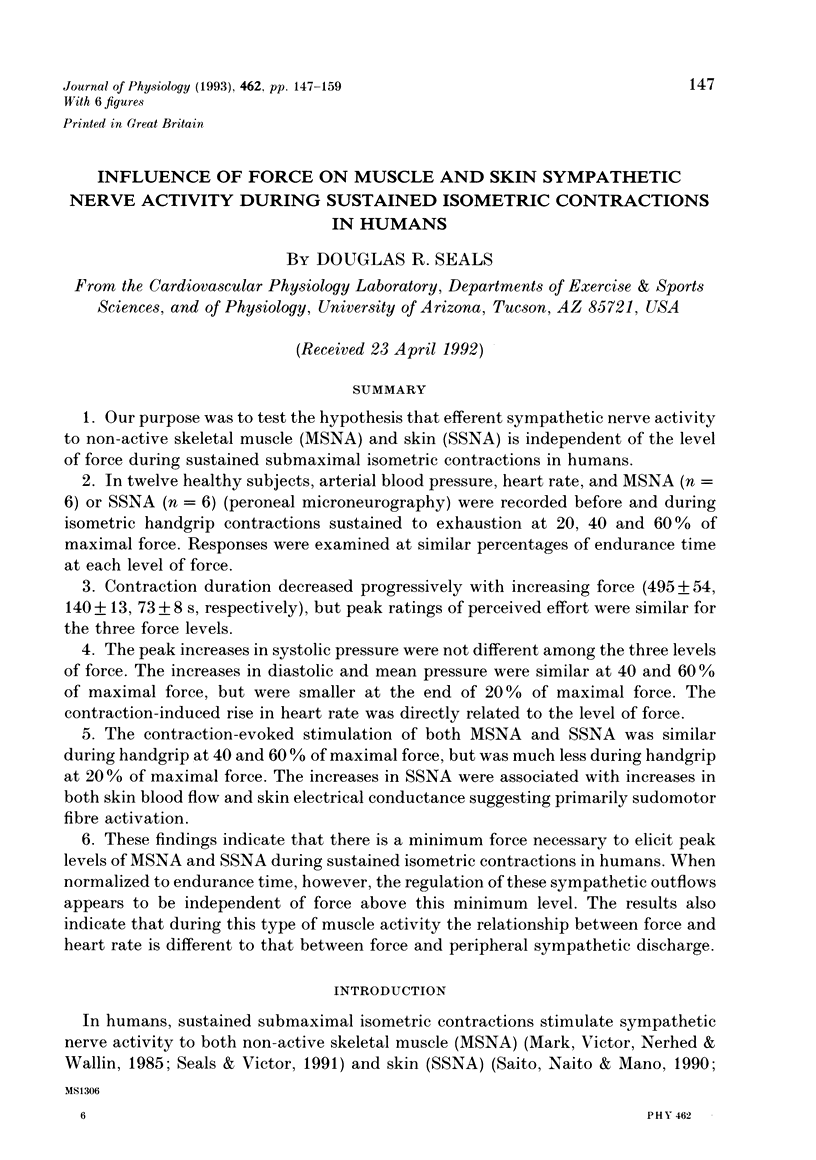
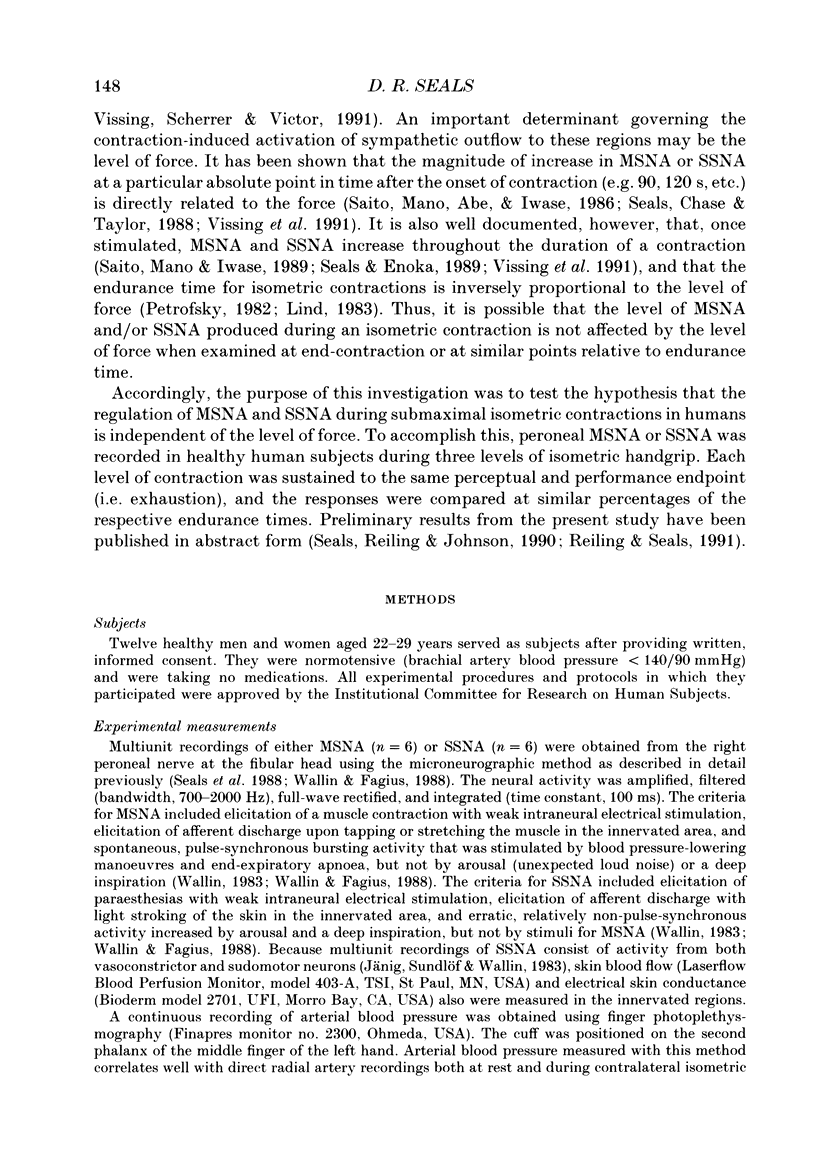
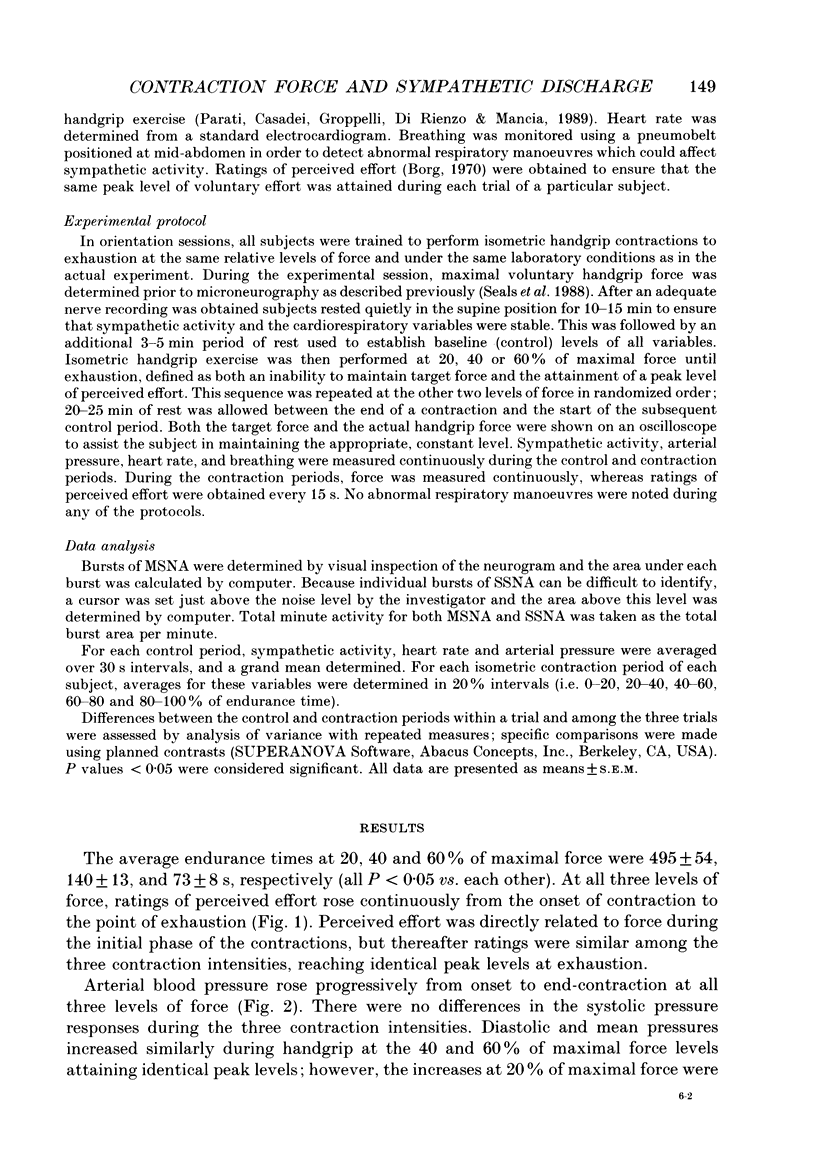
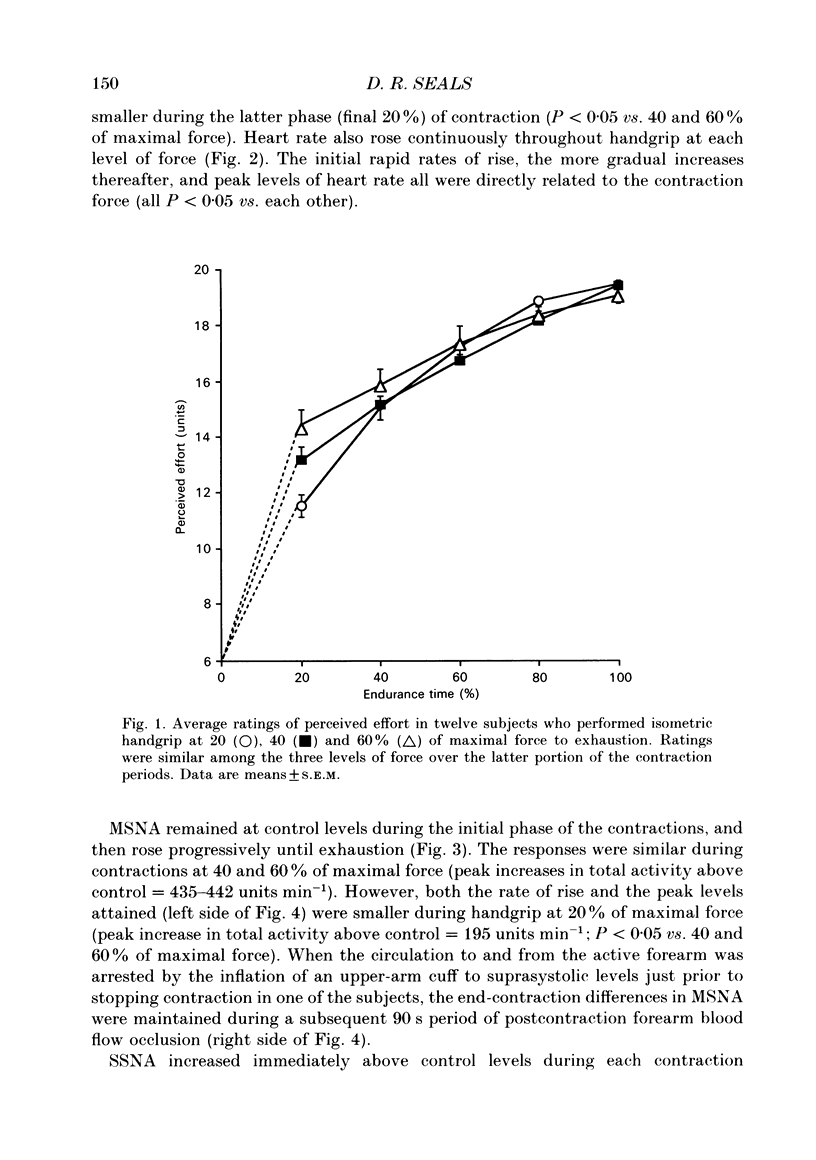
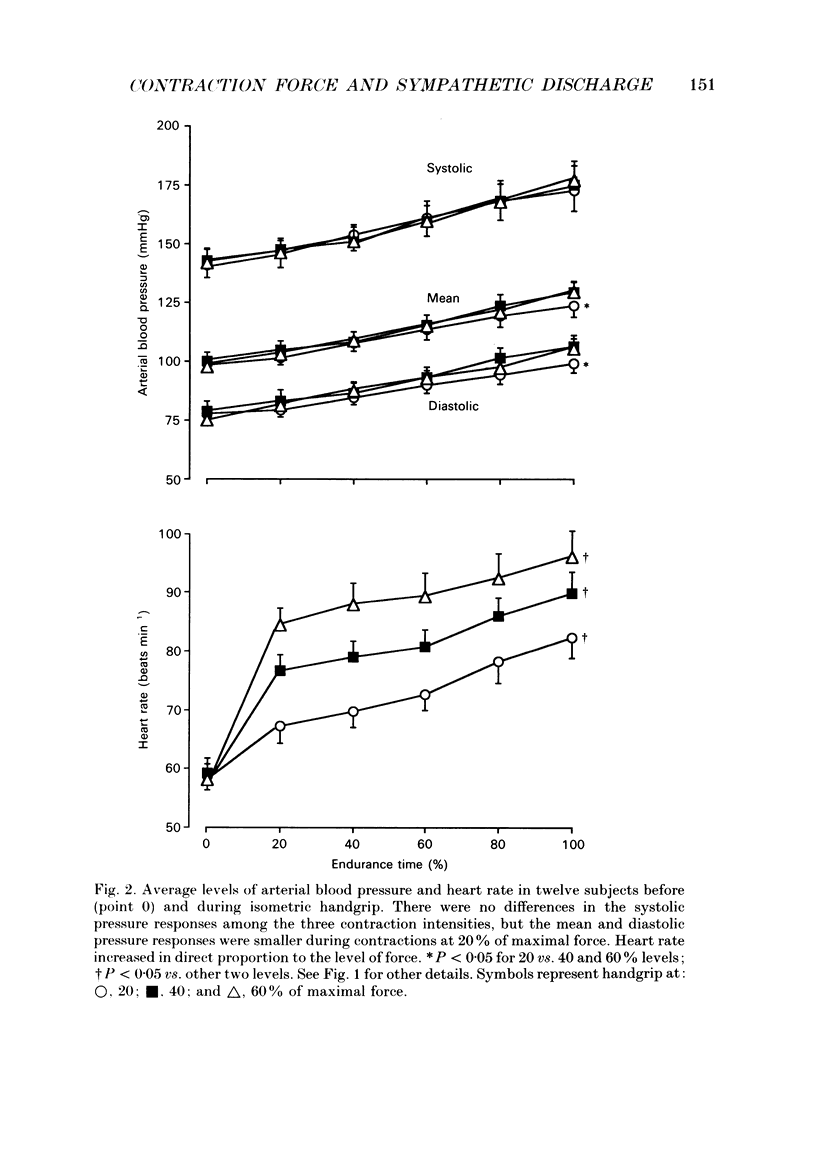
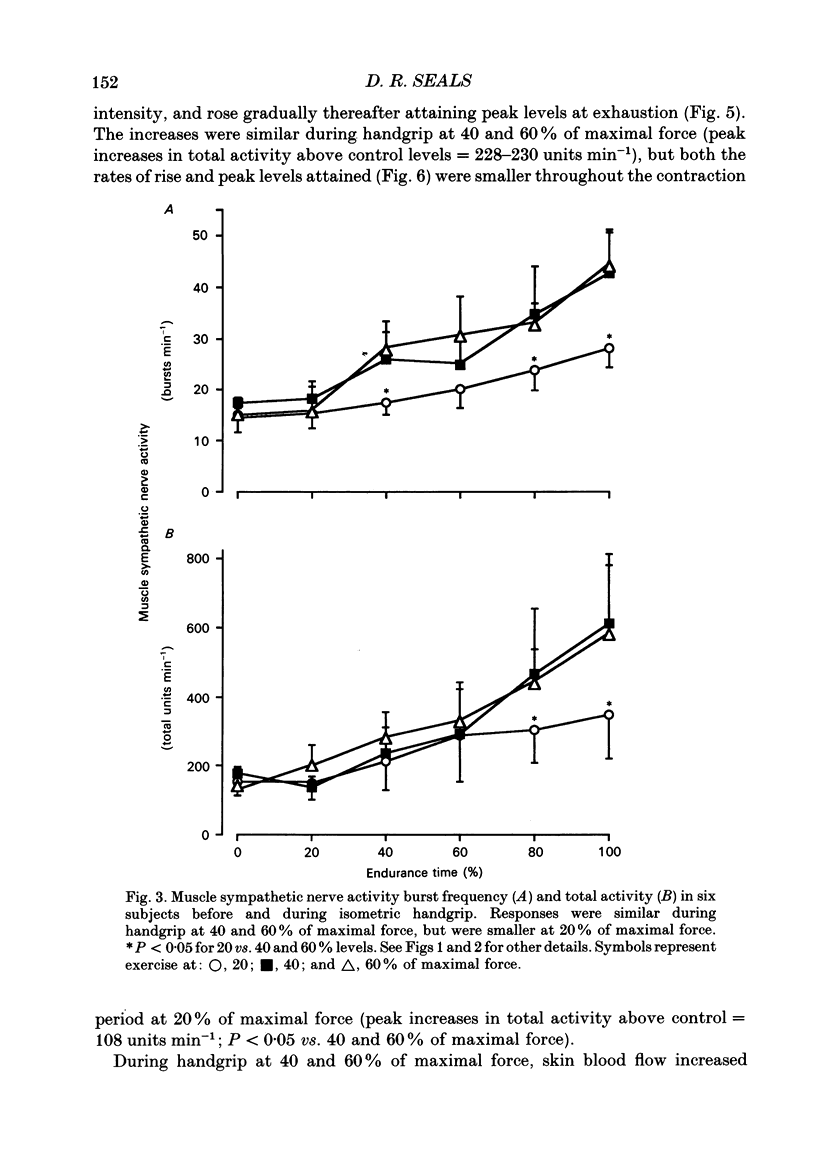
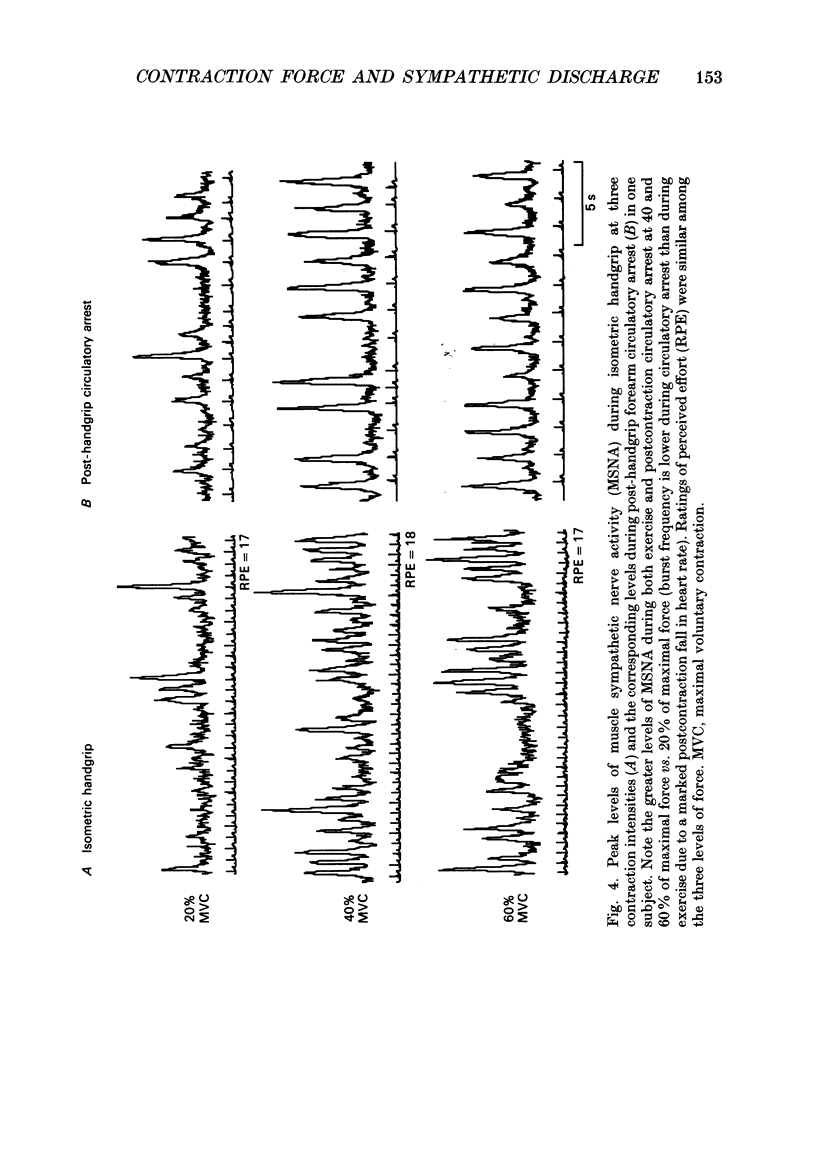
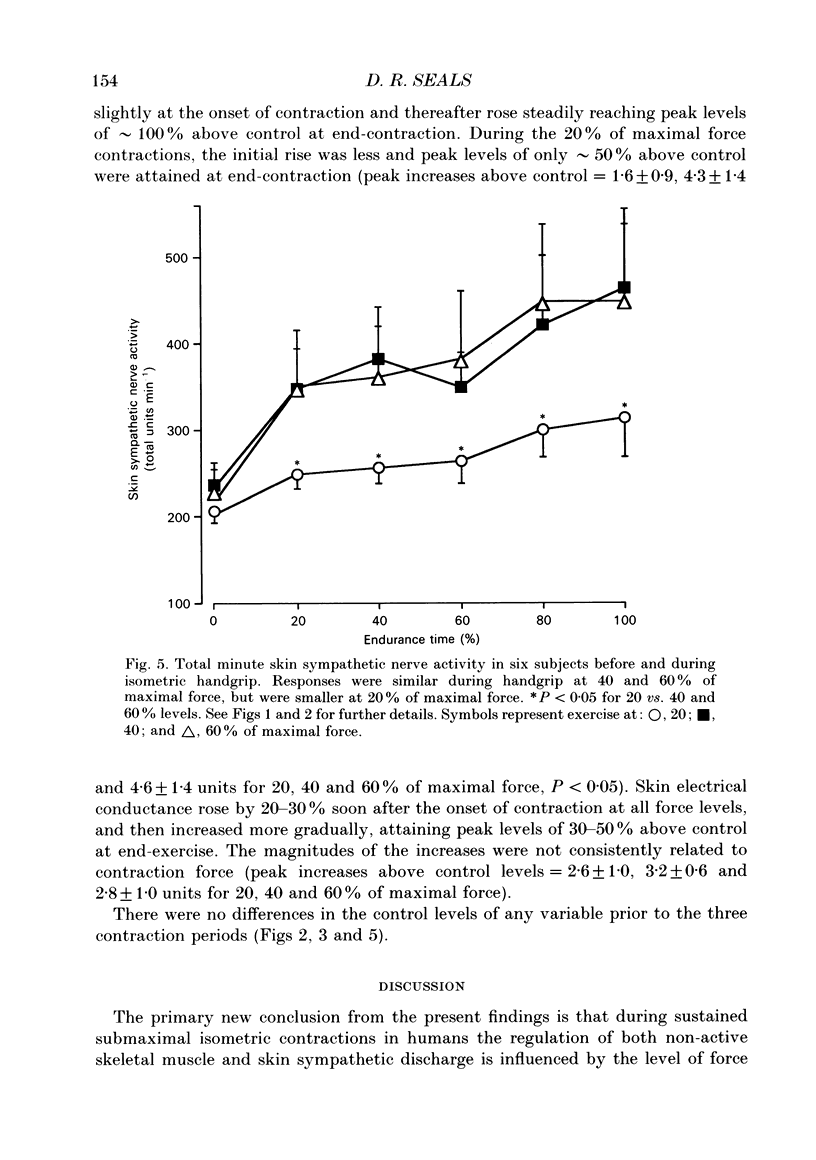
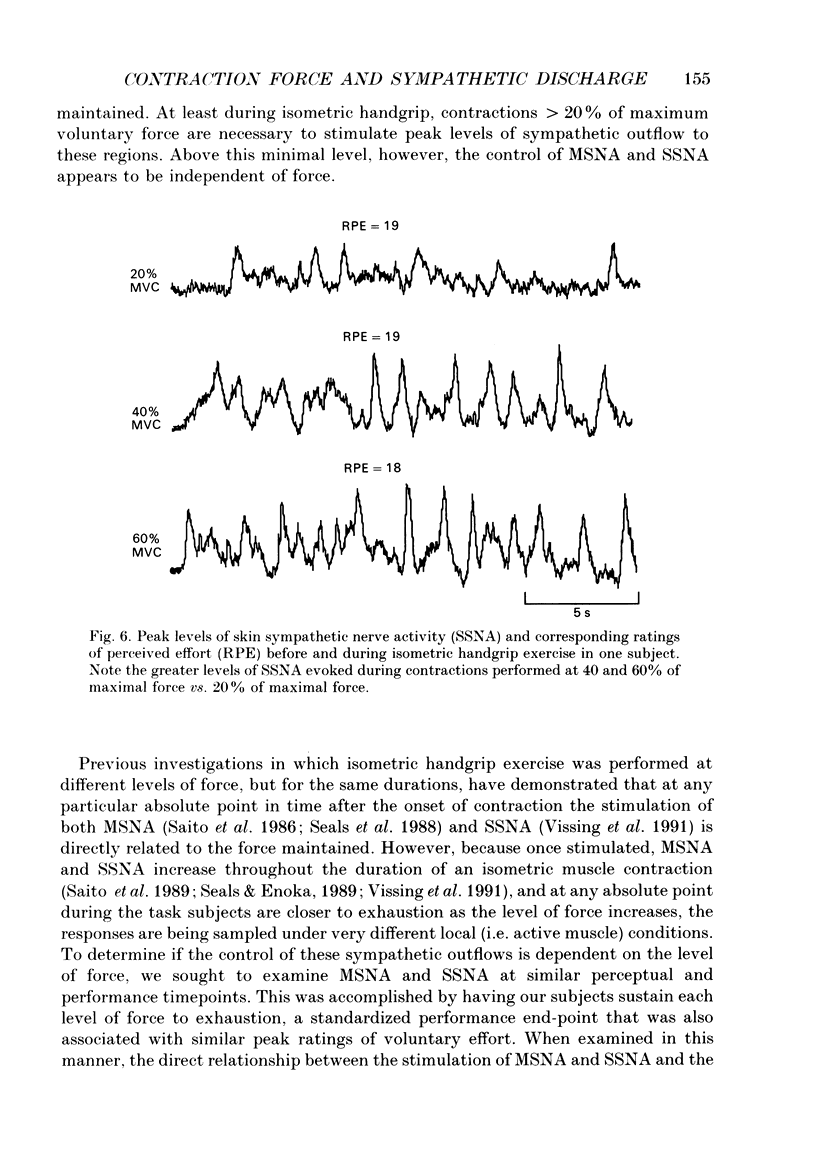
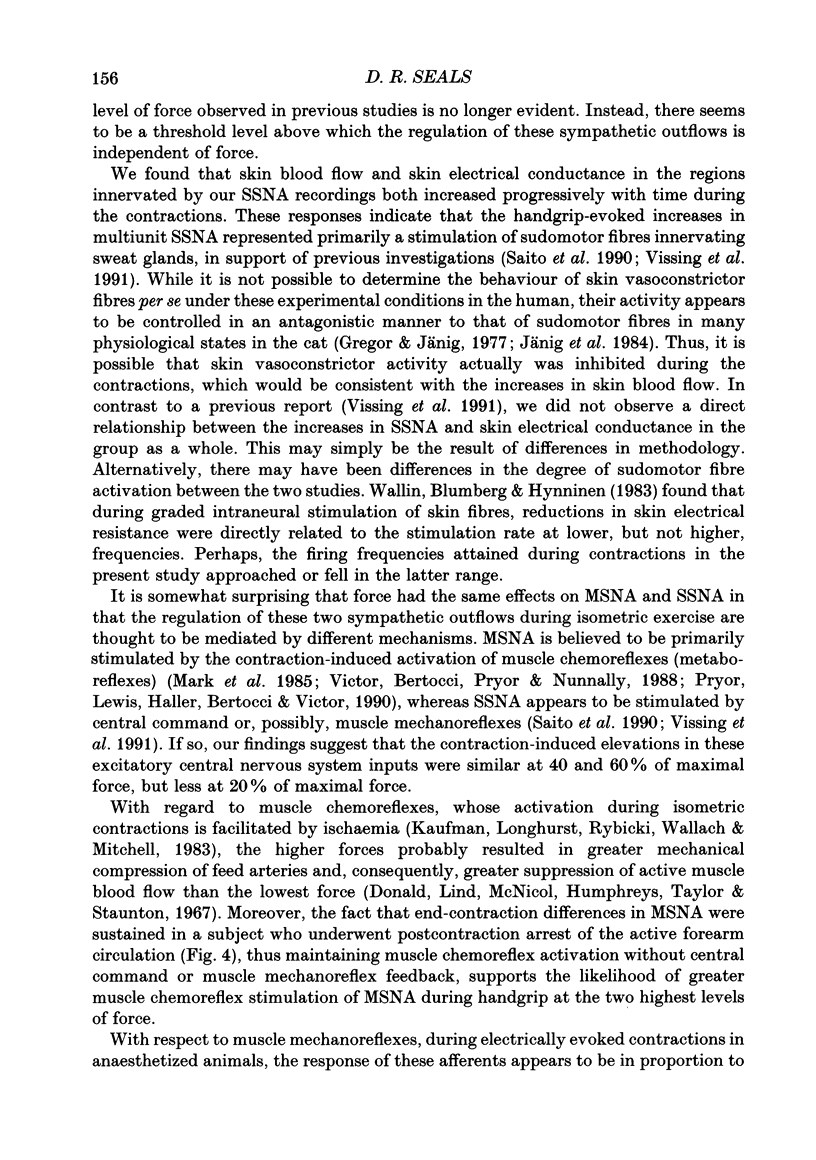
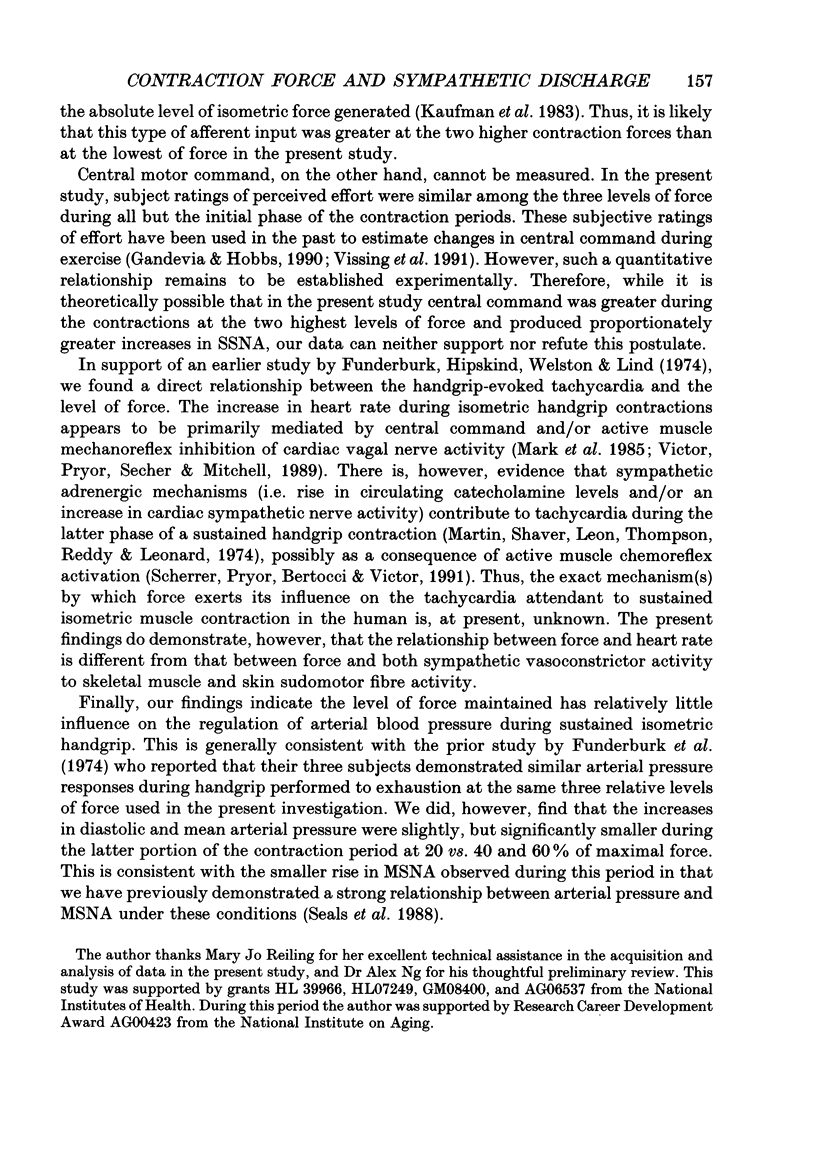
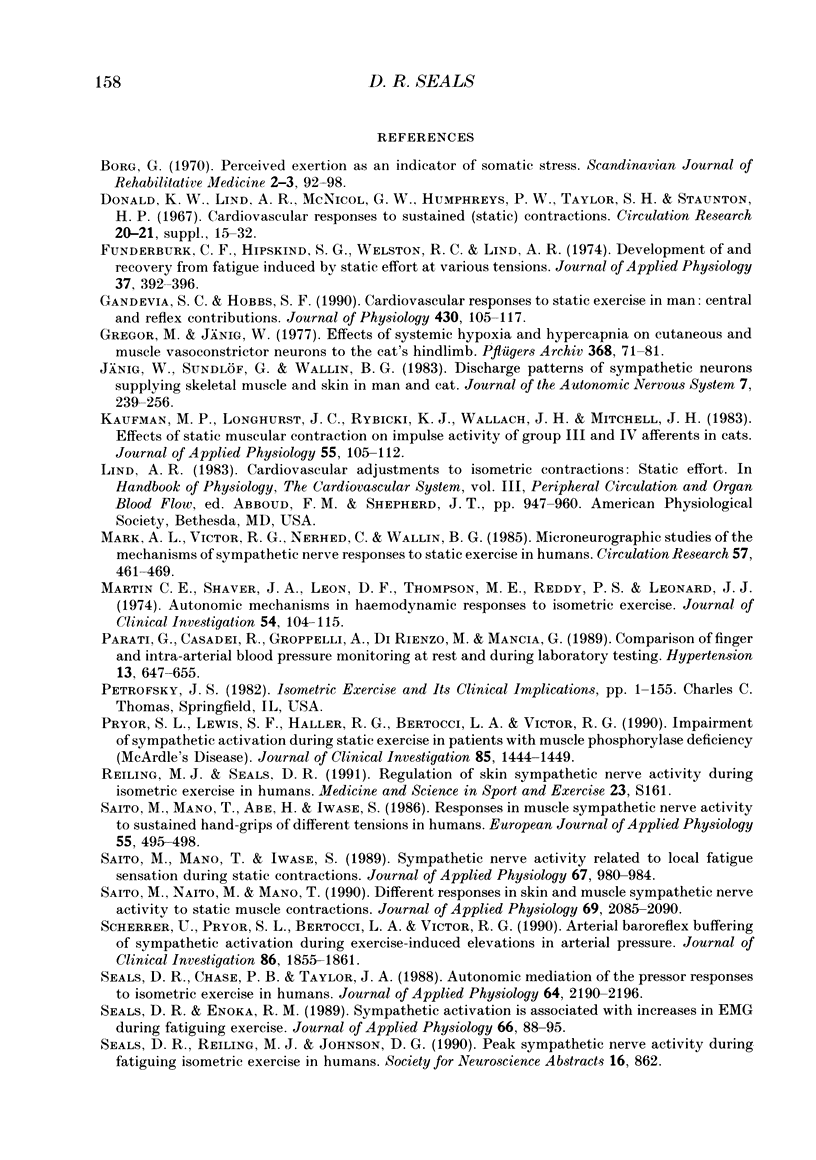
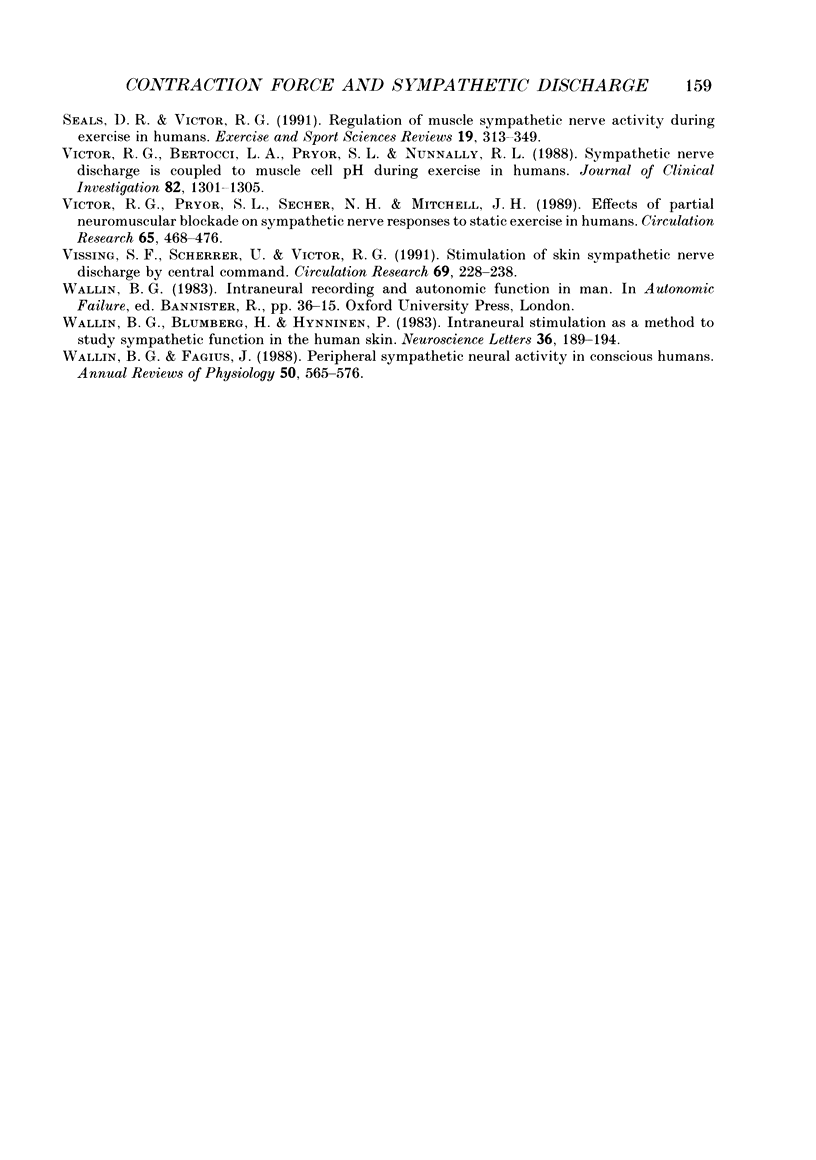
Selected References
These references are in PubMed. This may not be the complete list of references from this article.
- Borg G. Perceived exertion as an indicator of somatic stress. Scand J Rehabil Med. 1970;2(2):92–98. [PubMed] [Google Scholar]
- Funderburk C. F., Hipskind S. G., Welton R. C., Lind A. R. Development of and recovery from fatigue induced by static effort at various tensions. J Appl Physiol. 1974 Sep;37(3):392–396. doi: 10.1152/jappl.1974.37.3.392. [DOI] [PubMed] [Google Scholar]
- Gandevia S. C., Hobbs S. F. Cardiovascular responses to static exercise in man: central and reflex contributions. J Physiol. 1990 Nov;430:105–117. doi: 10.1113/jphysiol.1990.sp018284. [DOI] [PMC free article] [PubMed] [Google Scholar]
- Gregor M., Jänig Effects of sytemic hypoxia and hypercapnia on cutaneous and muscle vasoconstrictor neurones to the cat's hindlimb. Pflugers Arch. 1977 Mar 11;368(1-2):71–81. doi: 10.1007/BF01063457. [DOI] [PubMed] [Google Scholar]
- Jänig W., Sundlöf G., Wallin B. G. Discharge patterns of sympathetic neurons supplying skeletal muscle and skin in man and cat. J Auton Nerv Syst. 1983 Mar-Apr;7(3-4):239–256. doi: 10.1016/0165-1838(83)90077-2. [DOI] [PubMed] [Google Scholar]
- Kaufman M. P., Longhurst J. C., Rybicki K. J., Wallach J. H., Mitchell J. H. Effects of static muscular contraction on impulse activity of groups III and IV afferents in cats. J Appl Physiol Respir Environ Exerc Physiol. 1983 Jul;55(1 Pt 1):105–112. doi: 10.1152/jappl.1983.55.1.105. [DOI] [PubMed] [Google Scholar]
- Mark A. L., Victor R. G., Nerhed C., Wallin B. G. Microneurographic studies of the mechanisms of sympathetic nerve responses to static exercise in humans. Circ Res. 1985 Sep;57(3):461–469. doi: 10.1161/01.res.57.3.461. [DOI] [PubMed] [Google Scholar]
- Martin C. E., Shaver J. A., Leon D. F., Thompson M. E., Reddy P. S., Leonard J. J. Autonomic mechanisms in hemodynamic responses to isometric exercise. J Clin Invest. 1974 Jul;54(1):104–115. doi: 10.1172/JCI107731. [DOI] [PMC free article] [PubMed] [Google Scholar]
- Parati G., Casadei R., Groppelli A., Di Rienzo M., Mancia G. Comparison of finger and intra-arterial blood pressure monitoring at rest and during laboratory testing. Hypertension. 1989 Jun;13(6 Pt 1):647–655. doi: 10.1161/01.hyp.13.6.647. [DOI] [PubMed] [Google Scholar]
- Pryor S. L., Lewis S. F., Haller R. G., Bertocci L. A., Victor R. G. Impairment of sympathetic activation during static exercise in patients with muscle phosphorylase deficiency (McArdle's disease). J Clin Invest. 1990 May;85(5):1444–1449. doi: 10.1172/JCI114589. [DOI] [PMC free article] [PubMed] [Google Scholar]
- Saito M., Mano T., Abe H., Iwase S. Responses in muscle sympathetic nerve activity to sustained hand-grips of different tensions in humans. Eur J Appl Physiol Occup Physiol. 1986;55(5):493–498. doi: 10.1007/BF00421643. [DOI] [PubMed] [Google Scholar]
- Saito M., Mano T., Iwase S. Sympathetic nerve activity related to local fatigue sensation during static contraction. J Appl Physiol (1985) 1989 Sep;67(3):980–984. doi: 10.1152/jappl.1989.67.3.980. [DOI] [PubMed] [Google Scholar]
- Saito M., Naito M., Mano T. Different responses in skin and muscle sympathetic nerve activity to static muscle contraction. J Appl Physiol (1985) 1990 Dec;69(6):2085–2090. doi: 10.1152/jappl.1990.69.6.2085. [DOI] [PubMed] [Google Scholar]
- Scherrer U., Pryor S. L., Bertocci L. A., Victor R. G. Arterial baroreflex buffering of sympathetic activation during exercise-induced elevations in arterial pressure. J Clin Invest. 1990 Dec;86(6):1855–1861. doi: 10.1172/JCI114916. [DOI] [PMC free article] [PubMed] [Google Scholar]
- Seals D. R., Chase P. B., Taylor J. A. Autonomic mediation of the pressor responses to isometric exercise in humans. J Appl Physiol (1985) 1988 May;64(5):2190–2196. doi: 10.1152/jappl.1988.64.5.2190. [DOI] [PubMed] [Google Scholar]
- Seals D. R., Enoka R. M. Sympathetic activation is associated with increases in EMG during fatiguing exercise. J Appl Physiol (1985) 1989 Jan;66(1):88–95. doi: 10.1152/jappl.1989.66.1.88. [DOI] [PubMed] [Google Scholar]
- Seals D. R., Victor R. G. Regulation of muscle sympathetic nerve activity during exercise in humans. Exerc Sport Sci Rev. 1991;19:313–349. [PubMed] [Google Scholar]
- Victor R. G., Bertocci L. A., Pryor S. L., Nunnally R. L. Sympathetic nerve discharge is coupled to muscle cell pH during exercise in humans. J Clin Invest. 1988 Oct;82(4):1301–1305. doi: 10.1172/JCI113730. [DOI] [PMC free article] [PubMed] [Google Scholar]
- Victor R. G., Pryor S. L., Secher N. H., Mitchell J. H. Effects of partial neuromuscular blockade on sympathetic nerve responses to static exercise in humans. Circ Res. 1989 Aug;65(2):468–476. doi: 10.1161/01.res.65.2.468. [DOI] [PubMed] [Google Scholar]
- Vissing S. F., Scherrer U., Victor R. G. Stimulation of skin sympathetic nerve discharge by central command. Differential control of sympathetic outflow to skin and skeletal muscle during static exercise. Circ Res. 1991 Jul;69(1):228–238. doi: 10.1161/01.res.69.1.228. [DOI] [PubMed] [Google Scholar]
- Wallin B. G., Blumberg H., Hynninen P. Intraneural stimulation as a method to study sympathetic function in the human skin. Neurosci Lett. 1983 Apr 11;36(2):189–194. doi: 10.1016/0304-3940(83)90263-x. [DOI] [PubMed] [Google Scholar]
- Wallin B. G., Fagius J. Peripheral sympathetic neural activity in conscious humans. Annu Rev Physiol. 1988;50:565–576. doi: 10.1146/annurev.ph.50.030188.003025. [DOI] [PubMed] [Google Scholar]


